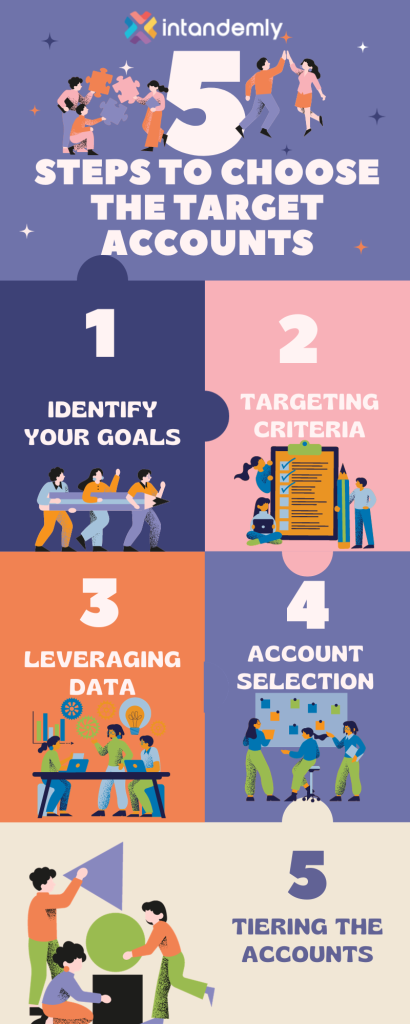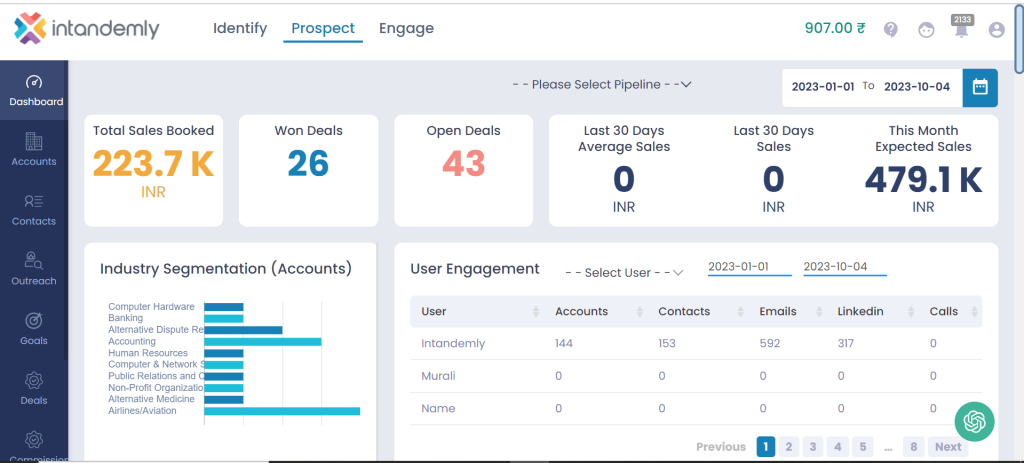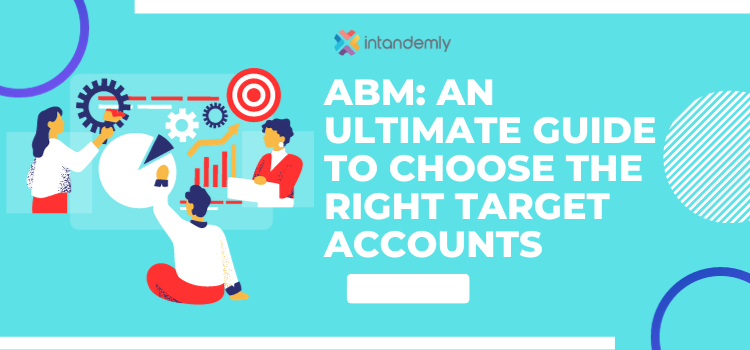ABM: An Ultimate Guide To Choosing The Right Target accounts
INTRODUCTION:
In the fast-paced world of modern marketing, Account-Based Marketing (ABM) has emerged as a powerful strategy to personalize and target high-value prospects effectively. By focusing on specific accounts, ABM enables businesses to tailor their efforts and deliver personalized experiences, ultimately increasing the likelihood of conversion.
However, the success of your ABM campaign heavily relies on selecting the right target accounts. In this ultimate guide, we will delve into the essential steps and ABM account selection criteria that will help you make the most of your ABM strategy.
As an organization, you may be implementing different levels of Account Based Marketing, from solely focusing on tiers of high-value accounts to simply folding your ABM campaign into broad demand gen strategy depending upon the market conditions.
Whether your objective is an acquisition or customer retention, a good going ABM process always starts with choosing the right customer accounts to target.
Identifying your target accounts should only be done with all the ABM stakeholders at the table.
Account selections vary according to organizational goals and strategies and for perfection, we can break down this list-building process into five phases.
5 Phases:
1. Understanding the ABM Approach:
Before diving into the account selection process, it's crucial to have a comprehensive understanding of ABM. Unlike traditional marketing, ABM concentrates on individual accounts rather than broad audiences. This customer-centric approach requires close collaboration between marketing and sales teams, focusing their efforts on key accounts with the highest potential value.
2.The ABM Account Selection Criteria:
To ensure your ABM campaign yields the desired results, you must establish well-defined criteria for selecting target accounts. Here are some essential criteria to consider:
a. Ideal Customer Profile (ICP):
Identifying your Ideal Customer Profile is the first step in selecting target accounts. A great place to start looking for target accounts is within your existing customer base.These are businesses that are already familiar with your brand and have a proven track record of doing business with you.
Analyze to identify common traits, including company size, industry, revenue, and location. For example, look for companies in similar industries or that have similar customer demographics. This will help you narrow down your focus to accounts that align closely with your successful customer profile.
Criteria for ICP
Demographics: Analyzing the industry, company size, location, and revenue of your current best customers can help define your ICP.
Behavioral Data: Consider the past interactions and engagement levels of your best customers. What content resonated with them, and how did they engage with your brand?
Technographic Data: Evaluate the technology stack used by your ideal customers. Knowing the tools they use can help you tailor your solutions to their specific needs.
b. Revenue Potential:
Consider the revenue potential of each target account. This involves evaluating the account's current and future value, potential for upselling, and overall growth prospects. High revenue potential accounts should be given priority in your ABM strategy.
c. Fit with Your Solutions:
Ensure that your products or services align with the target account's needs and pain points. Conduct thorough research to understand their challenges and determine how your offerings can address them effectively.
d. Buying Signals:
Buying signals are indicators that an account is interested in your product or service. These can include things like website visits, content downloads, and form submissions.
You can use data from your marketing automation system and CRM system to identify target accounts that are exhibiting buying signals.These signals indicate the account's readiness to make a purchase, making them valuable prospects for your ABM campaign.
e. Influence and Decision-makers:
When choosing accounts for your ABM campaign, it's important to identify the key decision-makers and stakeholders within the target account. at each account. These are the people who have the authority to purchase your product or service.
You can use data from LinkedIn and other social media platforms to identify the key decision-makers at each target account.Understanding their roles, responsibilities, and influence on purchasing decisions will also help you tailor your messaging and outreach accordingly
SiriusDecisions found 30% of marketers that worked in an account-based manner reported greater than 100% engagement increase with their C-level targets.
3. Building Your Target Account List:
Once you have established the ABM account selection criteria, it's time to build your target account list. Leverage data-driven insights and market research to identify potential accounts that meet your criteria. Tools like CRM software, analytics platforms, and third-party data providers can be instrumental in this process.
4. Personalization is Key:
Remember, the core of ABM is personalization. Personalize your messaging and content to resonate with the specific needs and challenges of each target account. Craft compelling narratives that showcase how your solutions can give value and solve their pain points.
Diversify your outreach efforts by using multiple channels such as email, social media, webinars, and events. This approach ensures that your target accounts receive consistent and personalized messages across various touchpoints, increasing the likelihood of engagement.
- 79% of companies that exceed revenue goals have a documented personalization strategy
5.Track, Measure, and Optimize:
ABM is an ongoing process, and it's essential to continually monitor and optimize your strategy:
Track key performance indicators (KPIs) such as conversion rates, engagement levels, and revenue generated from target accounts. Regularly review these metrics to measure the effectiveness of your ABM efforts.
Be prepared to adapt your ABM strategy as needed. Market dynamics change, and so should your approach. This may involve refining your ICP, adjusting content, or re-evaluating your target accounts based on performance data and market changes.

5 Steps to Choose the Target Account:
Identify Your Goals
The first step in choosing the right accounts for your ABM campaign is to identify your goals.This means setting clear objectives for your sales and marketing efforts. What do you want to achieve with ABM? Are you looking to increase brand awareness, generate leads, or close more deals?ARe you aiming for revenue growth, market expansion, or customer retention?
Once you know your goals, you can start to narrow down your target list.For instance, if your goal is rapid revenue growth, you'll focus on high-value accounts with substantial purchase potential. Setting these goals guides the entire account selection process and ensures that your resources are directed toward accounts most likely to help you achieve your desired outcomes.
Targeting Criteria
Before you even start to decide on which accounts to target, you need to understand what type of accounts you’ll be best off going after.
Sometimes, it can be as simple as your CEO and Sales Directors determining which accounts to pursue, but in most of the cases, you may have several factors in defining the right accounts for the ABM campaign.
Here are a few factors you might consider when identifying the target accounts:
Profitability:
These are the accounts that are likely to bring you maximum revenue and have the highest lifetime value with minimum resources to support them.
Strategic Importance:
You might want to select those accounts that align with your business strategy. For example, if you are about to enter a new market, a respective big logo account can be ideal for you.
Product Fit:
It is when the needs or the demands of the customer perfectly aligns with the solution your product offers, makes them more likely to purchase.
Quick Wins:
Choose those accounts which typically have a less complex buying cycle or shorter purchase decision process due to their size or structure.
High Yield:
You might want to identify and target big fish accounts and their characteristics who are likely to generate higher revenue and bigger deal size for your sales team.
Competitors:
Whether to hit the competitors where it hurts or to merely because it is easier to switch the educated customers, you can target customers using the competitor's product.
Territories:
Sales territory is regional, industry, or account type and sales teams often have target accounts within their territories. Managing and helping sales build the pipeline in their territory will drive higher ROI.
While considering such factors, doing some further research to identify the accounts will help you surface the accounts which are most likely to be targeted through ABM. These are some tips on how to start researching about right accounts:
Talk to Sales:
Your sales teams will have great insights into which accounts are most likely to buy, as they might have communicated with companies that fell through. And sales teams are much more likely to provide their own list of target accounts, so by agreeing on account scoring metrics and looking for overlaps with your marketing list, you can score the remaining potential accounts.
Review Existing Opportunities:
Review the accounts that are the right fit to your target profile and have had an engagement in the past with your brand, as they are likely to be more receptive to your marketing and show quicker results.
Review Customer Relationship Management history:
Use your CRM data, to find customers who are likely to be in a quick win, high yield, and profitability categories, and create an ideal profile by looking at commonalities in accounts from each category.
Leveraging Data to Make Targeting Decisions
While using the right data will fuel your ABM campaign, not using, or even worse, using the wrong data will cause the system failure.
The data will help you make informed decisions when it comes to account selection and distribution.
Before you start your ABM process, you would want your sales and marketing ops to help with these three things:
CRM Data:
What does your CRM data tell you about the accounts in your database? Can your sales and marketing ops identify the trends in your highest value customers? Are there data gaps you need to fulfill for getting a clear view on potential accounts?

Predictive Analytics:
If you don’t know which accounts to target, consider working with your marketing ops to build predictive models. Predictive analytics is the way of applying machine learning, taking data from all the available internal and external sources, to determine those accounts showing the high propensity to buy.
Behavioral Data:
Behavioral data includes information about how accounts interact with your website, content, and social media pages. You can use behavioral data to identify target accounts that are already familiar with your brand and are interested in learning more about your product or service.
By leveraging data to make targeting decisions, you can ensure that your ABM campaigns are reaching the right accounts with the right message at the right time. This can lead to increased conversions and revenue.
Sales Territories:
Sales territories are defined geographical areas or customer segments.Sales territories can be used to target the right accounts for ABM in a number of ways.
One way to use sales territories for ABM is to target accounts within specific geographies. Each territory has a different set of ideology and culture. To personalize the outreach you should adhere to the respective regions.Prioritized accounts receive tailored strategies.
This relationship ensures efficient sales efforts, concentrating on high-potential accounts, increasing the likelihood of conversions, and aligning sales tactics with customer needs.
Account Selection
Once you have multiple lists of potential accounts, it is recommended you prioritize and narrow it down to choose the accounts which you exactly want to target.
Give priority to those accounts which are more relevant to you, i.e., the accounts where you have a good understanding of potential buyer journey or to those you already have abm account selection criteria, as it makes it easy to iterate quickly and identify areas of improvements.
Thinking in Tiers
As you develop the list of accounts to be targeted with your abm account selection criteria campaigns, you notice that there are many accounts and your priority to each account varies.
Thinking and talking about these differences between accounts in tiers will be of help in strategizing your account-based marketing.
For instance, the accounts that match exactly with ICP and most targeted accounts which would get more resources and time are tier 1, and your sales and marketing teams are much more dedicated to closing them.
Coming to tier 2 and others in the descending priority, you may have a larger target list and invest less into targeted programs.
As you go down the list to tier 3 the number of accounts in the tiers increases as it fails to match the exact ICP criteria.
This tier segmentation gives you an overview of prioritizing the efforts and personalization as well.
Some Additional Tips:
- Align Sales & Marketing Teams: Lead management is the critical piece in sales and marketing alignment and without proper planning and execution, leads from your target accounts will not flow smoothly through your sales funnel.Being responsible for both strategic and tactical level, your marketing ops will need inputs from both sales and marketing teams.
- A joint Marketo and Reachforce study found companies that use ABM become 67% better at closing deals when they sync their sales and marketing teams
- Use a combination of data and intuition: Don't rely on data alone to choose your target accounts. Use your intuition and expertise to identify accounts that are a good fit for your business.
- Be flexible: Your target list may change over time as your business grows and evolves. Be prepared to add and remove accounts from your list as needed.
CONCLUSION:
Your own goals, objectives, and business strategies are what will determine the reasons for selecting and pursuing specific companies or verticals.
However, choosing the right accounts is crucial and the beginning step of your ABM process, get this wrong and you are set up for failure.
On the other hand, nailing it to perfection by implementing at least a few of the above-mentioned tactics in account selection, your business will see ABM results and experience growth like never before.
Selecting the right target accounts is the foundation of a successful abm account selection criteria campaign. By following the abm account selection criteria and personalizing your approach, you can significantly improve your chances of engaging high-value prospects and driving meaningful results.
Remember, abm account selection criteria is an ongoing process that requires constant refinement, so continue to analyze and adapt your strategy as needed. With a well-defined approach, your ABM efforts are bound to yield exceptional results for your business.






![Content Marketing Trends-2024 [Comprehensive Guide]](https://www.intandemly.com/wp-content/uploads/2016/07/content-marketing-blog-banner-50x50.png)

